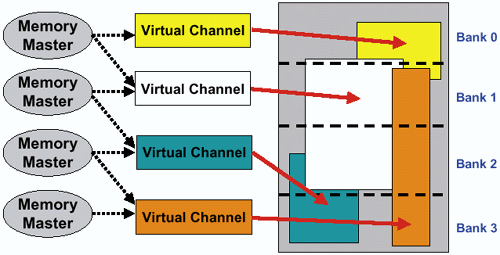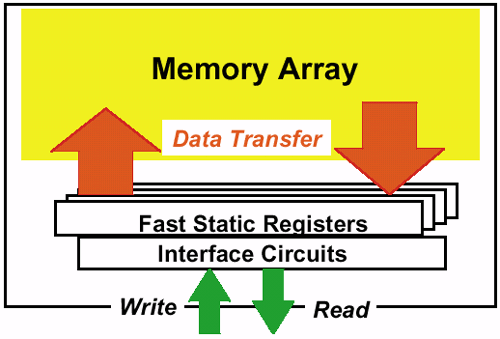VIA Apollo KX133 Athlon Chipset - Part 1
by Anand Lal Shimpi on February 7, 2000 11:51 PM EST- Posted in
- CPUs
Virtual Channel SDRAM – Where are you?
Originally covered in our review of VIA’s Apollo Pro 133A chipset, NEC’s Virtual Channel SDRAM is a work around for the memory bandwidth limitations of PC133 SDRAM in an AGP 4X compliant system.
It works like this: Virtual Channel Memory uses a set of high speed static registers (high speed memory) between the memory core and I/O pins (between the memory itself and its connection to the "outside world" or memory masters). These high speed registers provide each memory master (anything that accesses system memory) with its own "Virtual Channel" to the SDRAM. This helps reduce latency and increase the efficiency of the amount of bandwidth available to your system as a whole. This concept is better described by the diagram below:

Specifically, VC-SDRAM features 16 virtual channels, each 128 bytes in width. The 16 channels are split evenly among the two internal banks each VC-SDRAM module features.

Unlike DDR-SDRAM, VC-SDRAM does not increase memory bandwidth by a fixed amount but it frees up bandwidth for use as a result of greater memory bus efficiency. NEC claims a figure of up to 90% efficiency, but that depends entirely on the number of memory masters accessing memory and the nature of each access.
At the same time, VC-SDRAM does not decrease latency by a fixed amount; rather, it depends on the nature of the accesses it decreases the latency for simultaneous accesses by multiple memory masters.
While the KX133’s North Bridge does support VC-SDRAM, finding Virtual Channel SDRAM can be a bit tricky. Other than a few modules that have been floating around (two of which we were lucky enough to grab), VC-SDRAM is a general rarity in the market. After a bit of researching, all we could find out is that all of the VC-SDRAM chips being produced by NEC are being purchased by an unnamed OEM, and it isn’t even clear whether this OEM is using the chips for use on memory modules or for some other purpose.
Regardless, if you want to get your hands on VC-SDRAM, don’t waste your time. It doesn’t seem like it’s a viable option, especially since, if you ever decide to move to a chipset that does not support VC-SDRAM, your modules are not re-usable. While they work in regular 168-pin SDRAM slots, they won’t work unless the memory controller on the chipset specifically supports VC-SDRAM. That support is currently limited to three VIA chipsets: the Apollo Pro 133, the Apollo Pro 133A and the KX133.











0 Comments
View All Comments